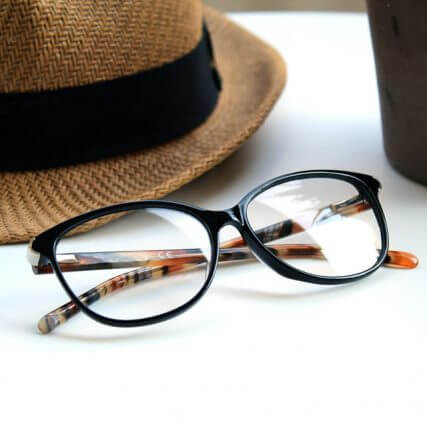Eyeglasses Near You in West Lebanon, New Hampshire
Lens treatments are available as individual additions to lenses, and are also commonly bundled into single lens products for convenience and maximum benefit to your eyes.
Popular Lens Coatings & Treatments:

UV protection is critical to eye health
There is no shortage of information about ultraviolet rays (UV) and how prolonged, unprotected exposure to UV can lead to skin damage. It’s why we wear sunscreen when we’re in the sun for extended periods of time. Sunscreens offer various degrees of UV protection by filtering out or “blocking” the harmful, invisible UVA and UVB wavelengths of light.
But did you know the same, serious approach to protecting your skin also applies to your eyes?
Eye exposure to ultraviolet rays can cause damage your eyes. Over time, UV can contribute to serious age-related eye conditions or diseases. That’s why wearing lenses with maximum UV protection is so very important. Because UV rays are always present outdoors—on sunny days, cloudy days and every day in between.
Unlike sunscreen that you apply and reapply, eyeglass lenses and sunglasses can have ultraviolet protection built into the lens, or applied as a lens treatment. Remember, although UV is invisible to the human eye, it is always present. Your lenses, therefore, should always provide UV protection.
The most important thing you need to know about UV glasses is this: Be certain your eyewear provides near or exactly 100% UV protection against both UVA and UVB rays. Anything less is less than ideal for the short and long-term protection of your healthy sight.
Scratch Resistant
There’s no such thing as scratch-proof lenses. (Even glass lenses can be scratched!) Scratches, while not likely to affect your lens performance, are an annoyance that can interfere with clear vision. That’s why you should always request scratch resistant lenses (treatment) for your eyeglass lenses.
Many of today’s lens products have hard scratch-resistant protection built into the lens—a hard surface treatment that is specifically designed to resist scratches. But it’s not an automatic feature! Be sure to discuss scratch resistant glasses options with your eye care professional.
We put our glasses through a lot from day to day—and our children, even more so. Scratch-resistant lenses can go a long way toward minimizing the everyday wear and tear we put on our eyewear.
Lens care for scratch-resistant glasses
Don’t forget, no treatment can completely protect eyeglass lenses from scratches. But you can help out! Remember to keep your glasses in a cushioned, sturdy case when not wearing them. Clean them regularly with warm, soapy water and dry them with a clean, soft cloth. With scratches as with life, a little extra care goes a long, long way.


Anti-Reflective
More comfort. Better vision. Reduced glare from oncoming headlights. Greater cosmetic appeal. It might be hard to believe, but anti-reflective lenses can provide all of these benefits—as an add-on for any number of lens products. The same technology used to provide anti-reflective benefits to precision lenses in microscopes and cameras, is now available to enhance your healthy sight.
An anti-reflective treatment applied on the front and the back of prescription lenses greatly reduces the light reflected by the lens surfaces. As a result, your eyes appear clearer behind the lenses, vision is more defined, and glare from reflected objects—especially headlights at night—is virtually eliminated. Plus, if you have a high-powered “strong” prescription, anti-reflective coating makes your eyes appear more natural.
How anti-reflective lenses works
Carefully calibrated layers of metal oxides are applied to the front and the back of the lenses. Each of these layers is designed to block reflected light. That includes glare, annoying reflections, and the hazy “halos” you often see around lights at night.
Take special care to use only the cleaning agents recommended by your eye care professional, as anti-reflective treatments are delicate by design. They work well for sunglasses too—but as a general rule should only be applied to the back side of the lens to eliminate glare reflected around the sides of the frame.


